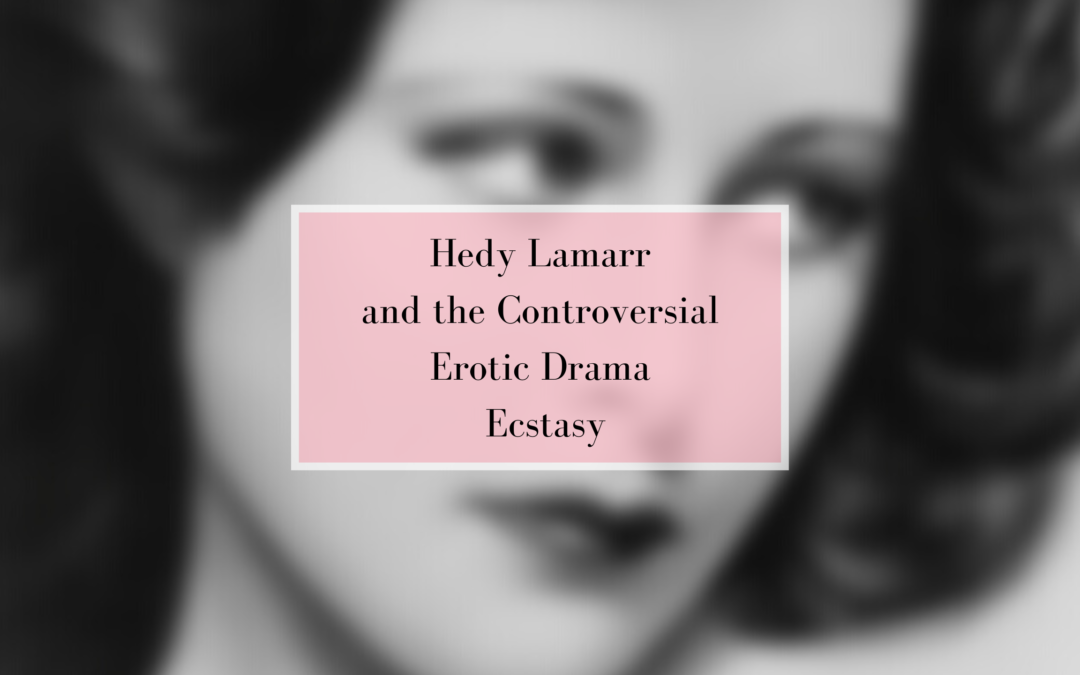When audiences stepped into the theater to watch the 1938 film, Algiers, they were immediately starstruck by the actress promoted as “the most beautiful woman in the world.” It was the American film debut of Hedy Lamarr, an actress well-known in Europe for her role in the controversial Czech film. Ecstasy (1933), which, in 1935, consequently became the first film banned from entering the United States by the U.S. Customs Service due to its obscenity.
Ecstasy was filmed in 1932 when Lamarr was just eighteen years old. She played Eva, a young girl who married an unromantic older man, Emil. Emil continuously denies Eva’s sexual advances so she returns home to her father’s estate and files for a divorce. It is there that she meets a young engineer named Adam and the two share a passionate night together.
The film notably features a scene of Lamarr running nude through forests and fields as well as sexual intercourse between Eva and Adam; the camera focuses on Hedy’s face as she simulates a female orgasm. Ecstasy made history as the first nonpornographic film to feature a sex scene and female orgasm. It is also allegedly the first film to display full frontal nudity.
The film officially premiered in Prague, Czechoslovakia on January 20, 1933. Though Ecstasy was considered artsy by some, its “obscene” nature outraged numerous countries and organizations, including the United States and Hitler’s Germany. The film was denounced by Italy’s Pope Pius XXI and was one of the first foreign films condemned by the United States Catholic Legion of Decency. Ecstasy was banned in countless countries.
Hedy attested that she was tricked into doing the nude scenes by director Gustav Machaty and only agreed to do the scenes if they placed the camera up on a hill, unaware that they would be using a telephoto lens. Other actors who considered the role claimed that the nude scenes were written very clearly in the script. Actresses Lupita Tovar and Adina Mandlova both said that they turned down the role when they read that nudity was expected in the script.
“When Lamarr applied for the role, she had little experience nor understood the planned filming. Anxious for the job, she signed the contract without reading it,” Liberty magazine published in 1938. “When, during an outdoor scene, the director told her to disrobe, she protested and threatened to quit, but he said that if she refused, she would have to pay for the cost of all the scenes already filmed. To calm her, he said they were using ‘long shots’ in any case, and no intimate details would be visible. At the preview in Prague, sitting next to the director, when she saw the numerous close-ups produced with telephoto lenses, she screamed at him for tricking her.”
In the 2010 book Hedy Lamarr: The Most Beautiful Woman in Film, it is reported that Ecstasty’s cinematographer Jan Stallich is quoted as saying, “As the star of the picture she knew she would have to appear naked in some scene. She never made any fuss about it during the production.”
Regardless, Hedy was dismayed at the reactions toward Ecstasy and did not accept additional roles in films for five years. She instead took successfully to the stage where fans and admirers often flocked to see her. She also married the wealthy chairman of a leading Austrian armaments firm, Fritz Mandl, in August of 1933. Mandl was enraged at his wife’s nudity in Ecstasy and spent a fortune ($280,000 – equivalent to $6.3 million today) buying up every
printed copy of the film. His attempts to stop the distribution of the film were unsuccessful as he was unable to purchase the master copy.
Distributor Samuel Cummins attempted to import a copy of Ecstasy to the United States in 1935, but the print was immediately seized; Ecstasy was banned from importation by the U.S. Customs Service for being “obscene and
immoral”. Cummins attempted to appeal this ruling but had no physical evidence to support him as the customs men had burned the imported copy.
A year later Cummins returned with a heavily edited copy of Ecstasy, but the film could only be played in a handful of art houses as it lacked a seal of approval from the Motion Picture Producers and Distributors of America (MPPDA). A series of legal battles over the censorship of Ecstasy in the United States ensued.
In Eureka Productions v. Lehman (S.D.N.Y 1936), a federal district court ruled that state officials could exercise their police powers and deny that a film they deemed to be obscene be shown. Eureka Productions v. Bryne (N.Y.S. 1937) ruled that state officials did not have to issue a permit because the film “unduly emphasizes the carnal side of the sex relationship.” (The First Amendment Encyclopedia, Middle Tennessee State University).
A series of letters from the MPPDA was sent throughout these legal battles. In one of them, film censor Joseph Breen writes that Ecstasy is “highly – even dangerously – indecent”. In another letter, he writes to Jewel Productions in Los Angeles, “I regret to have to advise you that we cannot approve your production Ecstasy that you submitted for our examination yesterday for the reason that is our considered unanimous judgment that the picture is definitely and specifically in violation of the Production Code. The violation is suggested by the basic story…in that it is a story of illicit love and frustrated sex, treated in detail without sufficiently compensating moral values.”
Though the film could run in arthouses without the seal of approval, it ran into stiff local censorship. Massachusetts ruled that the film could not be shown on Sundays. Pennsylvania banned the film entirely (later the Philadelphia Record named Hedy Lamarr the “most promising new actress of 1938” after the release of Algiers). Other states demanded that the film have substantial scene cuts if it were to be shown, such as eliminating shots of boxes of condoms, a scene that included the husband taking an aphrodisiac, all scenes depicting nudity, the scene of Eva showing shame, the scene of the horses preparing to breed, a scene of an iris flower, and countless others.
Back home Hedy was unhappy with her husband’s controlling nature and pro-Nazi sentiments, so she divorced Mandl and fled to London in 1937. It is there that she met Louis B. Mayer, head of the American film studio MGM, and he offered her a $125/week contract to come to America to make movies. She believed that offer to be too low and booked herself a ticket on the same New York-bound liner he would be returning to the United States on. There, she befriended Mayer’s wife who convinced Mayer to offer her a contract of $500/week.
Mayer reportedly warned Hedy, “no more dirty movies. We make clean pictures at MGM.” He also convinced her to go by Hedy Lamarr rather than her real name Hedy Kiesler to distance herself from her involvement with Ecstasy. Nevertheless, it wasn’t long before newspapers and magazines began reporting on Hedy as “the Ecstasy actress”, especially after the success of her first American picture Algiers.
“Scoring an immediate and outstanding success in her first American film, Hedy Lamarr, exotic Viennese beauty, promises to be the No. 1 glamor girl of Hollywood and threatens to displace Marlene Dietrich as leading screen siren,” an article titled “Nudist Nymph of Ecstasy now Toast of Filmdom” in the Calexico Chronicle read. “Hedy first gained fame as a nudist nymph in the foreign-made film Ecstasy, which is banned from the United States because of its daring sequences.”
“In Walter Wanger’s Algiers, there’s a thrill of a new personality in the exotic Hedy Lamarr,” another article titled “Ecstasy Girl in Algiers – Hedy Lamarr is an Exciting Beauty” read. “Hedy is a lady of some mystery. She arrived in Hollywood because of a picture called Ecstasy, wherein the grey-eyed, fascinatingly white-skinned brunette beauty revealed a great deal of herself for art’s sake.”
After many long, legal battles, Ecstasy was finally granted a seal of approval in 1940 after significant cuts were made to the film’s most controversial scenes, though some states still banned the film.
Despite all of the controversy surrounding Hedy’s involvement in Ecstasy, she quickly became one of the biggest glamor girls in Hollywood and continued to make films until 1958. She was heralded and celebrated for her beauty and intelligence – Hedy was inducted into the Inventors Hall of Fame in 2014 for patenting frequency hopping spread spectrum technologies.
Though Hedy Lamarr has been gone for 22 years, the stories of her inventive nature and sometimes controversial film career live on as strong as ever.
You can celebrate the life of Hedy Lamarr with Breakfast at Dominque’s officially licensed Hedy Lamarr – Cinnamon Bun Blend coffee.

Kaeli Bartholomew works in media and marketing through her company KPB Media. She loves music, writing, photography, and all things vintage!


Love the story! Hedy was ahead of the times.